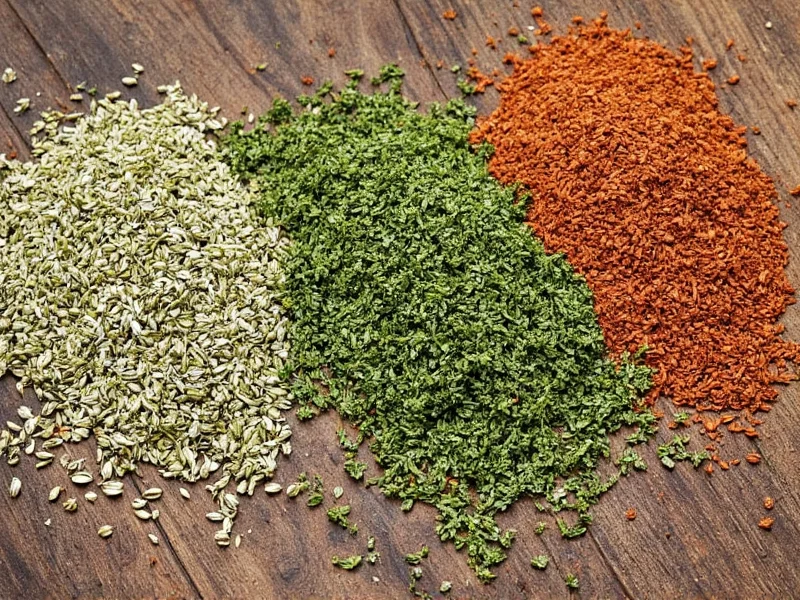Running out of oregano mid-recipe doesn't mean compromising your dish. This guide delivers practical oregano alternatives with precise measurements and culinary context—no guesswork required. Whether you're making pizza, Greek salad, or tomato sauce, you'll discover which herb substitutions preserve authentic flavor profiles while working with what's already in your pantry.
Understanding Oregano's Unique Flavor Profile
Oregano (Origanum vulgare) delivers a distinctive earthy, slightly bitter flavor with peppery notes and subtle citrus undertones. This Mediterranean herb contains carvacrol, the compound responsible for its robust, warm character that stands up well to cooking. Unlike delicate herbs added at the end, oregano's flavor intensifies when heated, making it essential in slow-simmered tomato sauces, grilled meats, and roasted vegetables.
When seeking oregano substitutes, consider two critical factors: flavor compatibility with your dish and whether you're using fresh or dried herbs. Dried oregano is typically three times more potent than fresh, so adjust substitutions accordingly. Most substitutes follow this same fresh-to-dried ratio principle.
Top 7 Oregano Substitutes Ranked by Culinary Effectiveness
| Substitute | Best For | Substitution Ratio | Flavor Comparison |
|---|---|---|---|
| Marjoram | Greek dishes, tomato sauces | 1:1 (dried) | Milder, sweeter version of oregano |
| Italian Seasoning | Pizza, pasta sauces | 1:1 | Blend containing oregano plus complementary herbs |
| Thyme | Meat dishes, stews | 1.5x amount | Earthy with lemon notes, less peppery |
| Basil | Fresh salads, Caprese dishes | 1:1 (fresh) | Sweeter, anise-like flavor |
| Rosemary | Roasted meats, potatoes | 0.5x amount | Strong pine-like flavor, use sparingly |
| Dried Mint | Greek lamb, tzatziki | 0.75x amount | Cooling effect, use in Mediterranean recipes |
| Savory | Bean dishes, grilled vegetables | 1:1 | Peppery with thyme-like notes |
Detailed Substitute Analysis
Marjoram: The Closest Flavor Match
Often called "oregano's sweeter cousin," marjoram shares the same botanical family but delivers a more delicate, floral profile. Use equal amounts of dried marjoram when substituting for dried oregano in Greek moussaka or Italian tomato sauces. For fresh applications like Greek salads, increase marjoram by 25% since its flavor is milder. Marjoram's lower carvacrol content makes it less assertive, so it won't overpower delicate dishes like fish or egg-based recipes.
Italian Seasoning: The Pantry Staple Solution
Most commercial Italian seasoning blends contain 30-50% oregano along with basil, rosemary, and thyme. This makes it the most practical substitute when you need immediate results. Use a 1:1 ratio for dried oregano in pizza sauces, meatballs, or salad dressings. For best results, choose blends listing oregano as the first ingredient. Avoid blends heavy on rosemary when making subtle dishes like seafood pasta.
Thyme: The Versatile Workhorse
Thyme provides earthy depth with lemony notes that complement oregano's peppery quality. When substituting in hearty dishes like beef stew or roasted vegetables, use 1.5 teaspoons of dried thyme for every 1 teaspoon of dried oregano. For fresh applications, increase to 2x the amount since fresh thyme has lower oil concentration. Thyme works particularly well in dishes containing tomatoes, garlic, and olive oil—the holy trinity of Mediterranean cooking.
Cuisine-Specific Substitution Guide
Not all oregano substitutes work equally well across different culinary traditions. Match your substitute to the dish's cultural origins for authentic results:
- Italian cuisine: Use Italian seasoning (1:1) or thyme (1.5x) in tomato-based sauces. Avoid strong substitutes like rosemary in delicate seafood dishes.
- Greek recipes: Marjoram (1:1) or dried mint (0.75x) work best in tzatziki and lamb dishes. Traditional Greek oregano has higher oil content, so reduce substitutes by 20%.
- Mexican dishes: Use Mexican oregano if available (1:1), otherwise combine marjoram with a pinch of cumin for authentic flavor in bean dishes.
- Mediterranean salads: Fresh basil (1:1) or a blend of thyme and marjoram preserves the bright, herbal quality.
Creating Your Own Custom Oregano Blend
When no single substitute meets your needs, create a balanced blend:
- Mix 2 parts dried marjoram with 1 part dried thyme and 0.5 parts dried basil
- Add a pinch of red pepper flakes for authentic oregano heat
- Store in an airtight container away from light
- Use within 3 months for optimal flavor
This blend mimics oregano's complex flavor profile better than any single herb. For pizza applications, increase the thyme ratio; for Greek dishes, emphasize marjoram. Always taste and adjust before finalizing your recipe.
When Substitution Doesn't Work
Certain dishes rely on oregano's unique chemical composition. Avoid substituting in:
- Traditional Greek ladolemono sauce where oregano's bitterness balances olive oil
- Authentic Neapolitan pizza where Protected Designation of Origin regulations specify oregano
- Some medicinal applications where carvacrol content matters
In these cases, consider modifying your recipe rather than forcing a substitution. Sometimes skipping the herb entirely produces better results than an inappropriate substitute.
Storage Tips for Maximum Flavor Preservation
Proper storage extends the shelf life of your oregano substitutes:
- Keep dried herbs in airtight containers away from heat and light
- Replace dried herb substitutes every 6-12 months (they lose 30% potency annually)
- Freeze fresh herb substitutes in olive oil for cooking applications
- Test potency by rubbing between fingers—strong aroma indicates freshness
Remember that older herbs require increased quantities—use 25% more aged substitutes to compensate for flavor degradation.











 浙公网安备
33010002000092号
浙公网安备
33010002000092号 浙B2-20120091-4
浙B2-20120091-4